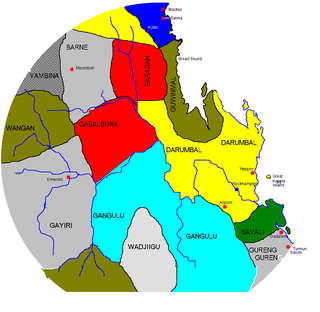
The Gabulbarra people, also rendered Gabalbura, Gabalbara and Kabalbara, were an Aboriginal Australian people of an area in eastern Central Queensland, but there is little recorded information about them.

The Gabulbarra people, also rendered Gabalbura, Gabalbara and Kabalbara, were an Aboriginal Australian people of an area in eastern Central Queensland, but there is little recorded information about them.
Gabulbarra traditional lands were estimated by Norman Tindale to encompass roughly 6,700 square kilometres (2,600 sq mi) around the areas to the west of the Mackenzie and Isaac rivers as far as Peak Range. Their northern limits lay close to Cotherstone. [1]
Gavan Breen says that the name alludes to a Central Queensland group who spoke a Biri dialect. The origin of the name is from gabul, the word for "carpet snake", so it means "carpet snake people". [2]
Other spellings of the name include Kabelbara, Kaiabara, Gabelbara, and Gabulbara.
Geoffrey O'Grady also assigned the name Yettimaralla. [2]
There has been no linguistic information recorded for this language, but they may have spoken a dialect of the Biri language. [2]
There is an entity known as the Gabulbarra Reference Group registered in Townsville, [3] which lodged two native title claims over parts of Magnetic Island in 1998, but this group was acting for the Wulgurukaba people of Townsville and the Manbarra people of Palm Island. [4] [5]
The Djugun are an Aboriginal Australian people of the Kimberley region of Western Australia.
The Gidabal, also known as Kitabal and Githabul, are an indigenous Australian tribe of southern Queensland, who inhabited an area in south-east Queensland and north-east New South Wales, now within the Southern Downs, Tenterfield and Kyogle Local Government regions.
The Manbarra, otherwise known as the Wulgurukaba, are Aboriginal Australian people, and the traditional custodians of the Palm Islands, Magnetic Island, and an area of mainland Queensland to the west of Townsville.
The Ngaro are an Australian Aboriginal group of people who traditionally inhabited the Whitsunday Islands and coastal regions of Queensland, employing a seafaring lifestyle in an area that archaeologically shows evidence of human habitation since 9000 BP. Ngaro society was destroyed by warfare with traders, colonists, and the Australian Native Police. The Native Police Corps forcibly relocated the remaining Ngaro people in 1870 to a penal colony on Palm Island or to the lumber mills of Brampton Island as forced labourers.

The Gangulu people, also written Kangulu, Kaangooloo, Ghungalu and other variations, are an Aboriginal Australian people from the Mount Morgan area in Queensland, Australia.
The Darumbal people, also spelt Darambal and Dharumbal, are the Aboriginal Australian people who have traditionally occupied Central Queensland, speaking dialects of the Darumbal language. Darumbal people of the Keppel Islands and surrounding regions are sometimes also known as Woppaburra or Ganumi, and the terms are sometimes used interchangeably.
Wanggamala, also spelt Wanggamanha, Wangkamahdla, Wangkamadla, Wangkamanha, Wangkamana, Wonkamala, Wongkamala, Wonkamudla, and other variants, is an extinct Australian Aboriginal language of the Pama–Nyungan family, previously spoken in the Northern Territory around Hay River and to the south of the Andegerebinha-speaking area.
Biri, also known as Biria, Birri Gubba, Birigaba, Wiri, Perembba and other variants, is an Australian Aboriginal language of the Mackay area of Queensland spoken by the Birri Gubba people. There are at least eight languages regarded as dialects of Biri, and two which are related but whose status is not yet fully determined. All are covered in this article.
The Gia people, also known as Giya, Kia, Bumbarra, and variants, are an Aboriginal Australian people of the state of Queensland. Little is known of them.
The Wiri are an Aboriginal Australian people of an area on the eastern side of the state of Queensland. They speak a dialect of the Biri language called Wiri.
The Mutumui were an indigenous Australian people of northern Queensland.
The Wanggamala people, also spelt Wangkamahdla, Wangkamadla, Wangkamanha, Wangkamana, Wonkamala, Wongkamala, Wonkamudla, and other variants, are an Aboriginal Australian people of the Northern Territory and Queensland.
The Kuku Buyunji (Kokobujundji), alternatively known as the Kuku Nyungkal or Annan River tribe are an indigenous Australian people of the state of Queensland.
The Pitapita or Pitta Pitta are an Aboriginal Australian people of the state of Queensland.
The Yilba, also written Ilba and Jilba, are or were an Aboriginal Australian people of the present-day state of Queensland.
The Yetimarala, also written Jetimarala and Yetimarla and also known as Bayali, Darumbal, Yaamba and other names and variant spellings, were an Aboriginal Australian people of eastern Queensland.

The Yambina were an Aboriginal Australian people of the state of Queensland, whose traditional lands lie inland (westwards) some distance from Mackay.
The Yukulta people, also spelt Jokula, Jukula, and other variants, and also known as Ganggalidda or Gangalidda, are an Aboriginal Australian people of the state of Queensland.
The Marulta were an indigenous Australian people of the state of Queensland, Australia.
The Kukatj are an Aboriginal Australian people of the Cape York Peninsula in the state of Queensland. They are to be distinguished from the Kukatja of Western Australia and the Luritja of the Northern Territory, who have also historically been known as Kukatja.